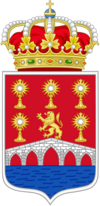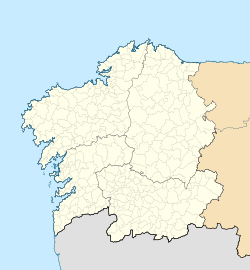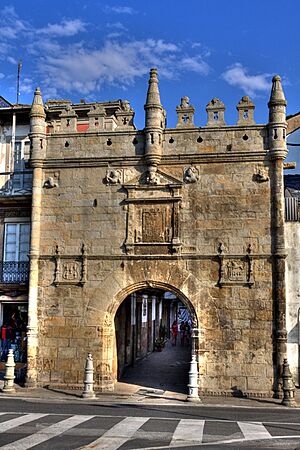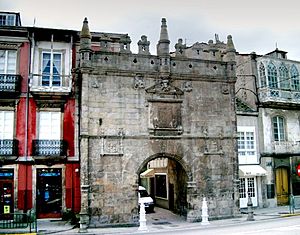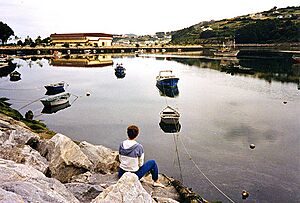Viveiro facts for kids
Quick facts for kids
Viveiro
|
|||
|---|---|---|---|
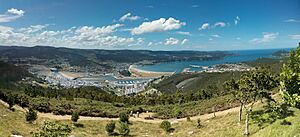
Panoramic view
|
|||
|
|||
| Country | Spain | ||
| Community | Galicia | ||
| Province | Lugo | ||
| Comarca | A Mariña Occidental | ||
| Area | |||
| • Total | 109.3 km2 (42.2 sq mi) | ||
| Elevation | 12 m (39 ft) | ||
| Population
(2018)
|
|||
| • Total | 15,510 | ||
| • Density | 141.90/km2 (367.53/sq mi) | ||
| Demonym(s) | Viveirenses | ||
| Time zone | UTC+1 (CET) | ||
| • Summer (DST) | UTC+2 (CEST) | ||
| Postal code |
27850
|
||
Viveiro is a beautiful town and municipality in the province of Lugo, located in the region of Galicia, Spain. It's part of the comarca called A Mariña Occidental. Viveiro is right next to the Cantabrian Sea, west of Xove and east of O Vicedo. About 15,500 people live here permanently (based on 2018 numbers). However, in the summer, the population can triple as many visitors come to enjoy the coast!
Contents
Discovering Viveiro's Geography
Viveiro has a mild oceanic climate. This means it usually has cool summers and mild winters, with plenty of rain.
The municipality of Viveiro includes the main town of Viveiro itself. It also has other important towns like Covas and Celeiro. More than half of all the people living in the municipality call these three places home.
Viveiro is divided into smaller areas called parroquias (parishes). These include Area-Faro, Boimente, Chavín, Galdo, Landrove, Magazos, San Pedro, Valcarría, Celeiro, Vieiro, Covas, and Viveiro.
Exploring Viveiro's Historic Sights
Long ago, a wall was built around Viveiro. It helped protect the people from attacks and diseases like the plague. Today, only parts of this old wall remain. You can still see some sections in the older part of the city.
Three of the original gates from the wall are still standing:
- Vila Gate
- Valado Gate, which has a Romanesque style.
- Castelo da Ponte Gate, also known as the Carlos V Gate. This gate is a symbol of Viveiro. It has the sculpted imperial arms of Emperor Carlos V, along with the original arms of the kingdom and the city's own arms.
You can also find old mansions that belonged to noble families. One example is a house with a gunsmith's design carved in stone.
Religious buildings are also important here:
- The Concepcion Monastery was founded by María das Alas Pumariño.
- The Ecce Homo Chapel, also called the Chapel of Pity, was built thanks to Rodrigo Alonso Alfeirán.
Viveiro is home to several Romanesque buildings. These are very old and have a special architectural style. They include the churches of San Pedro, Santa María, and San Francisco. The bridge over the Landro River also dates back to the medieval times.
Viveiro's Exciting Festivals
Viveiro has many fun festivals throughout the year, both traditional and religious.
Celebrating Carnival
Viveiro's Carnival is the oldest in Galicia! It happens for four days before Lent, from Saturday until Shrove Tuesday. The celebration ends on Tuesday with a big parade of floats through the streets.
Holy Week Traditions
Holy Week in Viveiro is a very important celebration in Galicia. Since 2013, it has been recognized as a Fiesta of International Tourist Interest of Spain. Many religious groups, called cofradías, take part. These include the Virgin of the Rosario, the Christ of the Piety, the Seven Last Words, and the Holy Cross.
During Holy Week, there are special processions:
- The Encounter shows the journey of Christ to Calvary with religious statues.
- The Unnailed and St. Funeral processions show Jesus being taken down from the Cross.
- Other processions feature scenes like the Last Supper, the Garden of Gethsemane (Horto), Ecce Homo, the Nazarene, and Our Lady of Sorrows (Sufferings). There are also processions for the Passion, the Seven Words, the Piety, and the Virgin at the foot of the Cross. Some of these are silent processions.
Rapa das Bestas: Wild Horse Tradition
This unique festival takes place on the first Sunday of July. If July 1st is a Sunday, it happens on the second Sunday instead. It's celebrated in the Buio Mountains. This is a very old tradition where people gather wild horses, cut their manes and tails, brand them, and break them in.
Patron Saint Celebrations
On August 15th, Viveiro celebrates its patron saints, Saint Roque and the Virgin Mary.
The Naseiro Pilgrimage
This pilgrimage, also known as "The pilgrimage of the good meal," is celebrated on the fourth Sunday of August. It's a time for good food and community gathering.
Saint James' Day
On July 25th, Viveiro celebrates Saint James' Day. This happens at the Port of Celeiro with a special marine procession through the estuary of Viveiro.
Other Fun Events
Every year, usually in late July or early August, Viveiro hosts the Resurrection Fest. This is a big music festival that focuses on metal, hardcore, and punk music. It has been held in the city since 2006.
Famous People from Viveiro
Many notable people have come from Viveiro, including:
- Gómez Pérez das Mariñas (1539–1593): A politician, diplomat, and military officer who was a colonial governor of the Philippines.
- Nicomedes Pastor Díaz (1811–1863): A politician and a writer known for his Romantic style.
- Antón Vilar Ponte (1881–1936): A writer and politician.
- Jesús Cora y Lira (1890–1969): An admiral and Carlist politician.
- Maruja Mallo (1902–1995): A famous surrealist painter.
- Lois Tobío Fernández (1906–2003): A journalist and philologist (someone who studies language).
- Carlos Oroza (1933–2015): A well-known poet.
Viveiro's International Connections
Viveiro has special connections with other cities around the world, called "twin towns" or "sister cities." This helps build friendships and cultural exchange.
 Lannion, France
Lannion, France Old Havana (Havana), Cuba
Old Havana (Havana), Cuba Perth, Australia
Perth, Australia
See also
 In Spanish: Vivero para niños
In Spanish: Vivero para niños



